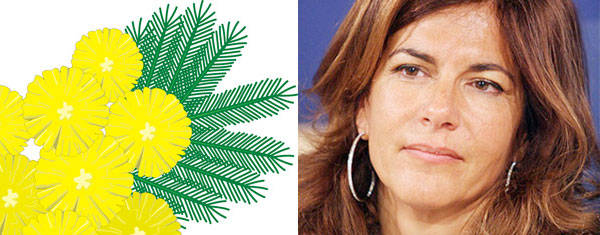Italy’s Most Powerful Woman
ROME – Female DJ’s in Roman disco dance spots in the wee hours Sunday. A women’s military unit standing guard all day at the Quirinal Palace. Free lessons in self-defense for women in Villa Ada park. The annual celebration La Giornata delle Donne March 8, which began in the Seventies with gifts of mimosa sprigs and dancing in Campo de’ Fiori beneath the severe gaze of Giordano Bruno, is still marked by folklore and symbolism.
Down at Ermete’s café I asked the women gossiping around a table how they would describe women’s condition in Italy today. The answer came quickly, in a chorus: “Tragic.”
But of course this is not true, and if one judges a society by its heroic figures, the picture that emerges show a degree of an equality, including of frustration, unheard of in the Seventies. As a reporter I personally attended the first ever meeting in Rome of the Movimento per la Liberazione delle Donne (MLD). At the end of the meeting the male politician who was chaperoning the meeting, held at the headquarters of the Radical party on Via di Torre Argentina, insisted on seeing my notebook so that I would not publish anything untoward in the New York Times. For me, his insistence (I refused) said it all. Nothing similar could happen these days.
So what does happen? Although several attractively youthful and well dressed women hold cabinet slots today, they and their achievements are dwarfed by Emma Marcegaglia, 44-year-old daughter of a steel tycoon and for the past year head of the powerful and prestigious Confindustria, Italy’s National Association of Manufacturers. Marcegaglia recently called upon the government of Silvio Berlusconi to draft a credit plan to help out the small- and medium-sized industries which are, as is universally recognized, the backbone of Italian commerce. She explained her request on grounds of a serious worldwide recession which is affecting Italy. She argued for more investments in infrastructure as well as eased credit on grounds that statistics show a reduced GDP, jobs being lost, and consumer spending dropping in Italy as elsewhere.
“Enough of the crows out there,” snarled the Minister for Economic Development Claudio Scajola. “The research centers”—and he specified the OCSE and FMI—“like to spread pessimism.” Crows, as everyone here knows, are birds of doom and gloom.
She wasn’t forgetting the slight. “I don’t think I’m a crow,” she retorted. “I’m one of the few who still thinks that at the end of 2009 we’ll see a bit of improvement in our country.” It’s the government that must do more, she added.
The government’s official line has been media directed—to go on singing in the rain (“making reassurances rather than an action plan,” as one disgruntled reader put it in a letter to a newspaper). Nevertheless, this past week government spokesmen were obliged to admit that she was right—and used the same gloomy, doomy figures she had. Finance Minister Giulio Tremonti admitted that 2009 is looking to be “a terrible year,” with a GDP down 2.6% over last year, and public debt soaring to 110% of GDP, as the EU Commission had already predicted. “It’s the mother of all crises,” Massimo Giannini wrote Friday in La Repubblica. The title of his article: “The Crow’s Tale.”
My own prediction: government ministers come and go. Marcegaglia is here to stay, Italy’s most powerful woman.





































i-Italy
Facebook
Google+
This work may not be reproduced, in whole or in part, without prior written permission.
Questo lavoro non può essere riprodotto, in tutto o in parte, senza permesso scritto.